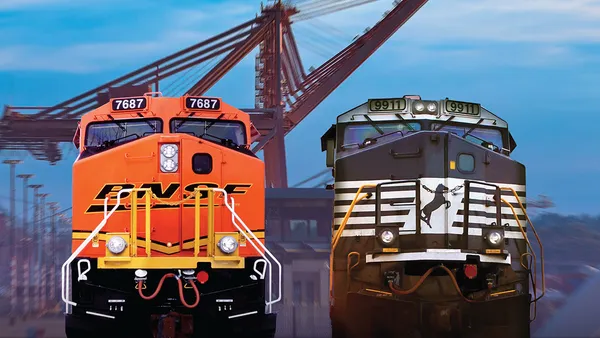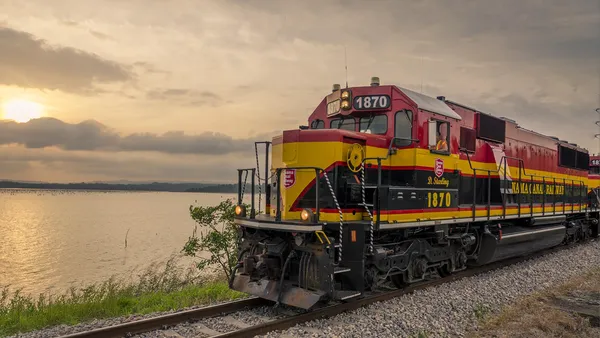Dive Brief:
- The last six months for CSX have been defined by "historic volatility," with Q2 bringing a record-setting downturn in volume and Q3 having "record sequential increases," CEO James Foote said on the company's earnings call Wednesday.
- The dramatic volume swings strained CSX's network, as velocity decreased by 3% YoY and car dwell increased 9% YoY, according to the company's quarterly release. Intermodal volume was up 7% YoY for the quarter, but this was more than offset by declines in every other category, as overall volume fell 3% YoY in Q3. This comes after the railroad's volume was down 20% YoY in Q2.
- CSX executives said the company is courting shippers in an attempt to get them to switch volume to intermodal, as sport rates soar in the trucking market. Intermodal trip plan compliance was more than 87% for the third quarter, a drop of more than 7% YoY, though executives said it improved throughout Q3.
Dive Insight:
While CSX's network may have been squeezed by the recent unpredictability — as seen in the slower speeds and longer dwell time — the carrier assured analysts that it has plenty of room to grow and wouldn't have to spend to make it happen.
"We have got a ton of capacity and availability to bring on more business from a physical infrastructure perspective, without spending any capital to do that," Foote said.
This ability to increase and decrease the size of its network allowed the carrier to weather the pandemic-driven unpredictability better than it might have in the past, he said.
"If you would [have] had this kind of traffic surge across the rail network in North America four, five years ago, we would be now talking about gridlock across all the major cities in the country, and we wouldn't be doing anything," Foote said. "And now, with the common mindset of how you run a railroad, we are able to respond; we are able to pivot; we are nimble; we can add capacity; we can shrink capacity."
The railroad, like the majority of the other Class I railroads, has dramatically changed its operational structure as it has adopted precision scheduled railroading in recent years.
And CSX is not alone in focusing in on intermodal market as one area that can bring in more business to fill that capacity. Kansas City Southern executives said Friday that it is working to improve trip plan compliance for cross-border intermodal as it attempts to attract more shippers to the offering.
"As we all know, the 12% to 15% discount that rail offers, given with our good service product, has allowed us to go and sit down with our customers," and talk to them about moving more freight via train, Mark Wallace, the executive vice president of sales and marketing at CSX, told analysts. "And they can't get trucks. The truck market is tight. The spot rates are up. And so we are seeing conversions there."
J.B. Hunt, which relies on rail companies for its intermodal service, said congestion in Q3 was one issue standing in the way of growing that business line.
"Rail terminal congestion and a slower pace of unloading at customer destinations have contributed to a meaningful slowdown in the velocity of the supply chain and thus the productivity of our equipment," Darren Field, president of intermodal J.B. Hunt, said last week.
Wallace acknowledged that there's no guarantee that the railroad will keep all the intermodal conversions it has made and that getting shippers to stay will rely on the carrier's operating efficiency.
"If we are able to show the power of rail and keep performing like we know we can, hopefully, a lot of that traffic will stick on CSX going forward," he said.














